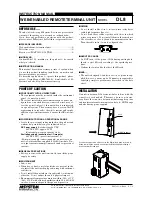
Section 10. Troubleshooting
527
the Compile, Save and Send feature of older versions of CRBasic
Editor.
o
A new program (even the same program) was inadvertently sent to
the CR3000 through the Connect client or Set Up client in
LoggerNet.
o
The program was stopped through datalogger support software File
Control or LoggerLink software.
•
The CPU: drive was inadvertently formated.
•
A network peripheral (NL115, NL120, NL200, or NL240) was added to
the CR3000 when there was previously no network peripheral, and so
forced the CR3000 to reallocate memory.
•
A hardware failure, such as memory corruption, occurred.
•
Inserting or removing memory cards will generally do nothing to cause
the CR3000 to miss data. These events affect table definitions because
they can affect table size allocations, but they will not create a situation
where data recovery is necessary.
Data can usually be recovered using the Datalogger Data Recovery wizard
available in DevConfig
(p. 113).
Recovery is possible because data in memory is
not usually destroyed, only lost track of. So, the wizard recovers "data" from the
entire memory, whether or not that memory has been written to, or written to
recently.
Once you have run through the recovery procedure, consider the following:
If a CRD: drive (memory card) or a USB: drive (Campbell Scientific mass storage
device) has been removed since the data was originally stored, then the
Datalogger Data Recovery is run, the memory pointer will likely be in the wrong
location, so the recovered data will be corrupted. If this is the case, put the CRD:
or USB: drive back in place and re-run the Datalogger Data Recovery wizard
before restarting the CRBasic program.
In any case, even when the recovery runs properly, the result will be that good
data is recovered mixed with sections of empty or old junk. With the entire data
dump in one file, you can sort through the good and the bad.
10.13 Troubleshooting — Miscellaneous Errors
10.13.1
Voltage Calibration Error!
An input to an analog channel maybe outside ±8 Vdc:
•
Use a volt meter to check between each analog input terminal and a
ground terminal that analog inputs are not greater than ±5 Vdc.
•
Check for condensation which may cause leakage of 12 Vdc into other
regions of CR3000 circuitry.
Summary of Contents for CR3000 Micrologger
Page 2: ......
Page 3: ......
Page 4: ......
Page 6: ......
Page 30: ......
Page 34: ......
Page 36: ......
Page 96: ......
Page 485: ...Section 8 Operation 485 8 11 2 Data Display FIGURE 110 Keyboard and Display Displaying Data ...
Page 487: ...Section 8 Operation 487 FIGURE 112 CR1000KD Real Time Custom ...
Page 491: ...Section 8 Operation 491 FIGURE 116 Keyboard and Display File Edit ...
Page 496: ......
Page 502: ......
Page 564: ...Section 11 Glossary 564 FIGURE 126 Relationships of Accuracy Precision and Resolution ...
Page 566: ......
Page 594: ......
Page 598: ......
Page 600: ......
Page 602: ......
Page 624: ......
Page 642: ......
Page 643: ......
















































